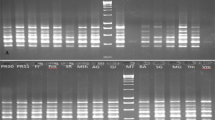Abstract
The investigated material consisted of the core collection of the Polish Pisum gene bank at Wiatrowo and represented a described, monohybrid variation (type lines for characters/genes and their initial lines, tester lines with markers and lines from wild taxa, 266 accessions in total). A polymorphism in 18 isozymic loci was analyzed (Lap-1, Px-1, Aat-p, Aat-m, Aat-c, Pgm-c, Pgm-p, Gpi-c, Idh, Acp-1, Skdh, Est-1, Est-2, Est-3, Aldo, 6Pgd-p, 6Pgd-c, Dia-1). The practical outcome of the analysis was a selection of lines with a high number of fast or slow isozymic alleles, useful as tester lines with markers for chromosome mapping. A polymorphism was stated in all investigated loci with 2 to 4 alleles ranging from very fast, fast, slow to very slow. Fast and slow alleles occurred in all loci. In 11 loci the incidence of fast alleles was higher than slow ones. Conversly, slow alleles occurred more frequently than fast ones in 5 loci. Additionally, there was a low incidence of a very fast allele in 7 loci and of a very slow allele in 3 loci. A slow allele was rare in 2 loci. Primitive lines and land races were a source of these rare alleles. It is suggested to consider a frequent allele of a given locus found in a group of wild lines as a so-called wild type of Pisum.
Similar content being viewed by others
References
Almgard, G. & K. Ohlund, 1970. Inheritance and location of a biochemical character in Pisum. Pisum Newslet. 2: 9.
Andersen, W.R. & D.J. Fairbanks, 1990. Molecular markers: important tools for plant genetic resource characterization. Diversity 6 (3-4): 51-53.
Blixt, S., 1978. Problems relating to pea breeding. Agri. Hort. Genet. 36: 56-87.
Frankel, O.H. & A.H.D. Brown, 1984. Plant Genetic Resources Today: A critical appraisal. In: Holden, J.H.W. & J.T. Williams (Eds.) Crop Genetic Resources: Conservation and Evaluation, pp. 249-257. George Allen & Unwin Ltd., London.
Hintum, Th.J.L. van, 1999. The core selector, a system to generate representative selections of germplasm collections. Plant Genetic Resources Newsletter 118: 64-67.
Matthews, P. & W.K. Świecicki, 1990. European Pisum Database. Tagungsbericht-Berlin, Akad. Landwirtschaftswiss., Berlin, 297: 199.
Matthews, P. & H. Williams, 1972. Genetics of root isoperoxidase variants in Pisum. John Innes Annual Report 63: 43-45.
Przybylska, J., S. Blixt, H. Parzysz & Z. Zimniak-Przybylska, 1982. Isoenzyme variation in the genus Pisum. I. Electrophoretic pattern of several enzyme systems. Genet. Pol. 23 (30): 103-121.
Przybylska, J., P¸agowska, E. & J. George, 1989. Isoenzyme variation in genus Pisum. VI. Further electrophoretic analysis of different enzyme systems. Genet. Pol. 30 (3-4): 129-138.
Świecicki, W.K., 1997. Gromadzenie i opracowanie zasobów genowych z rodzaju Pisum i Ornithopus. In: Ochrona Roślinnych Zasobów Genowych, pp. 105-106. Radzików (in Polish).
Świecicki, W.K., B. Wolko & K. Kruszka, 1998. Linkages in Pisum L.VII. Locus for the sterile gene calf (cabbage leaf). J. Appl. Genet. 39(2): 163-169.
Weeden, N.F. & L.D. Gottlieb, 1980. The genetics of chloroplast enzyme. J. Hered. 71: 392-396.
Weeden, N.F. & G.A. Marx, 1983. Linkage determinations for several isozymic loci in Pisum. Pisum Newslet. 15: 54-55.
Weeden, N.F. & G.A. Marx, 1984a. A gene coding isocitrate dehydrogenase is linked with D on chromosome 1. Pisum Newslet. 16: 75-76.
Weeden, N.F. & G.A. Marx, 1984b. Chromosomal locations of twelve isozyme loci in Pisum sativum. J. Hered. 75: 365-370.
Weeden, N.F. & G.A. Marx, 1987. Further genetic analysis and linkage relationships of isozyme loci in the pea. J. Hered. 78: 153-159.
Weeden, N.F. & B. Wolko, 1990. Linkage map for the garden pea (Pisum sativum) based on molecular markers. In: O'Brien, S.J. (Ed.), Genetic Maps. 5, pp. 6.106-6.112. Cold Spring Harbour Laboratory Press.
Weeden, N.F., W.K. Świecicki, O.M. Timmerman & M. Ambrose, 1993. Guidelines for future mapping studies in Pisum. Pisum Genetics 25: 13-14.
Weeden, N.F., W.K. Świecicki, G.M.T. Timmerman-Vaughan, T.H.N. Ellis & M. Ambrose, 1996. The current pea linkage map. Pisum Genetics 28: 1-4.
Wolko, B. & N.F. Weeden, 1989. Estimation of Lupinus genome polyploidy on the basis of isozymic loci number. Genet. Pol. 30 (3-4): 165-171.
Wolko, B. & N.F. Weeden, 1990. Two new isozyme loci on chromosome 2. Pisum Newslet. 22: 75-77.
Yndgaard, F. & A. Hoskuldsson, 1985. Electrophoresis: a tool for gene banks. Plant Genet. Res. Newslet. 63: 34-40.
Author information
Authors and Affiliations
Corresponding author
Rights and permissions
About this article
Cite this article
Świecicki, W.K., Wolko, B., Apisitwanich, S. et al. An analysis of isozymic loci polymorphism in the core collection of the Polish Pisum genebank. Genetic Resources and Crop Evolution 47, 583–590 (2000). https://doi.org/10.1023/A:1026546922516
Issue Date:
DOI: https://doi.org/10.1023/A:1026546922516



